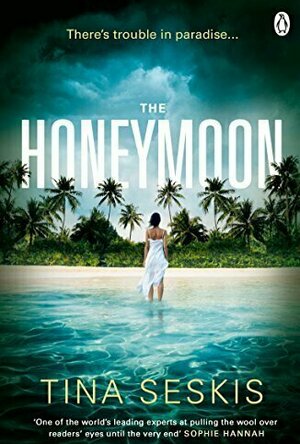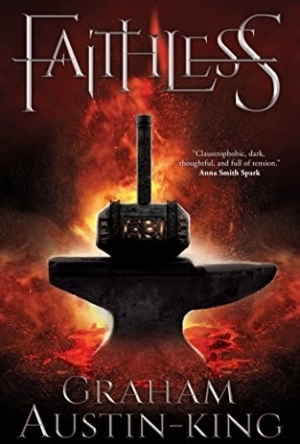BookInspector (124 KP) rated The Honeymoon in Books
Sep 24, 2020
The main character in this novel was Jemma. She is a girl, living in London and looking for love. With help of her friend, she finds a boyfriend, and the relationship starts. Jemma gets married and goes on a dream honeymoon, one night, while Jemma gets completely drunk, her husband disappears, and nobody can find him on this little island. The thing is, Jemma can’t remember what happened that night.
This novel is filled with very amusing and unique characters. I really liked their personalities, all except for Jemma. I did not like her decisions, and her personality was not pleasant to me. However, I loved the way Seskis used her in this novel, it was brilliant. I loved the way she manipulated Jemma’s character, in order to create suspense and different moods in the book. The story was told from different perspectives, and that made the book more enjoyable, as I sometimes got tired of Jemma’s “Where is my husband gone?”.
The narrative of this book was very interestingly designed. The quite boring investigation was backed up by a story from Jemma’s past, making the whole story more appealing. This book is divided into four parts, and every part finished with unexpected, course-changing turns and twists, which left me pleasantly baffled. Moreover, every part had a different structure to it, making this novel better with every page.
For the writing style of Tina Seskis, I can give nothing less than fantastic. She is an incredibly gifted writer, who knows, how to keep the reader hooked and interested. I strongly believe that she can make any book a gem to the readers. Seskis made the chapters short and to the point, which kept me glued to this book, I was “eating” chapters one after another, not because I wanted to, it was because I needed to.
Here I have a confession to make, while I was checking how many chapters there were in the book (85 in total), I accidentally saw, what I shouldn’t (it was hard to miss it…). The ending of this novel was absolutely shocking and unexpected, and I loved that the author allowed the characters involved to tell it from their perspectives. So, to conclude, there were some things which didn’t work for me, but overall, I strongly recommend this book to everyone, you simply need to experience this wonderful way, through which Tina Seskis is sharing this story, it is unique, clever and masterful, and I will be reading her work in the future for sure.
Darren (1599 KP) rated Viking (2016) in Movies
Jun 25, 2019
Thoughts on Viking
Characters – Vladimir is the youngster son of the king, he gets the weakest area to rule, but isn’t going to let that stop him taking control of the area, he proves to be a strong leader one that is fair and will look after his people. When it comes to the rest of the characters it was hard to figure out who to focus on, because as soon as one looked like they were going to be important, they seemed to get killed.
Performances – The performances suffer because of the issues with the characters not being given the focus they require in the film, it is too hard for the audience to know who they should be following in this film.
Story – The story seems to focus on Vladimir the youngest son of the rule of Russia, whom after his death gets given part of the land to defend, we watch his rise to try and claim his crown as the rule of Russia as he takes on enemies from all over the land including his own blood. The story telling process is difficult to keep up with as we do seem to meet group one get slightly invested in these character, but nope they get killed leaving us wondering just who we are meant to be supporting through the film.
Action/History/War – The action is plenty of battle sequences, each one getting bigger, bloodier and deadlier as the film unfolds. The history, well I don’t know how accurate any of it is, most of that would involve research and the war side of the film shows us the different strategies adopted during the 10th century.
Settings – The film shows us the settings that will keep us believing we are in the time the film is set, it keeps the battles feeling down and dirty which is how you would imagine them happening.
Scene of the Movie – The hiding escape.
That Moment That Annoyed Me – Too many characters introduced for nothing.
Final Thoughts – This is an overly complicated movie that is trying to tell a massive story only for it to end up not given enough time for most of the characters to develop or unfold.
Overall: Too long and dull
https://moviesreview101.com/2019/06/22/abc-film-challenge-world-cinema-v-viking-2016/
Bong Mines Entertainment (15 KP) rated Live From Studio Hotel Earth by Laura Jean Anderson in Music
Jun 25, 2019
The 6-track project contains songs from her debut EP, entitled, “Lonesome No More”, alongside a cover of The White Stripes’ “I’m Lonely (But I Ain’t That Lonely Yet)” single.
“I miss my mother, I miss being her one. As crazy as I was, I guess I wasn’t much fun. Sometimes, I miss her so much, want to hop on the next jet. I get lonely, but I ain’t that lonely yet.” – lyrics
‘I’m Lonely (But I Ain’t That Lonely Yet)’ tells a depressing tale of a young woman who is in need of human contact. Apparently, she doesn’t want to bother her loved ones, therefore, she doesn’t tell them that she misses them.
Later, she admits that sometimes she wants to give them a call, but doesn’t want to feel like a pest. Even though she feels regret for being desolate, she keeps on keeping on. What she really wants is to find a friend, someone who she can talk to one on one.
‘I’m Lonely (But I Ain’t That Lonely Yet)’ contains a gloomy storyline, ear-welcoming vocals, and guitar-driven instrumentation flavored with sentimental blues and folk elements.
“Making a record and having the vast possibilities of production and instrumentation is exciting, but there is something special about limitation. This live EP brings the songs back to how they were written. Back to those intimate moments of writing alone late at night with just me and my guitar. These songs are really personal to me. All about very vivid moments and stories of my life so being able to record them stripped-down and intimately was really emotional but beautiful. The day of the recording was really special for me. I’m a huge believer in the power of a community of people. So it was really special having my old friend Theo Karon record this in his new studio.” – Laura Jean Anderson
Laura Jean Anderson had a strict Mormon upbringing. During her teenage years, she used music as an outlet for rebellion and enhanced her vocal skill in church choirs.
After a bronchitis-ridden audition, she gained acceptance to California Institute of the Arts (CalArts), where she studied classical voice.
Since then, she has gained experience as a blue collared musician who built her career working odd jobs which involved painstaking hard labor.
Get acquainted with her music by streaming her “Live From Studio Hotel Earth” EP via Spotify.
Laura Jean Anderson recorded her “Live From Studio Hotel Earth” EP in one-take.
Also, this summer, she will embark on a tour as direct support with L.A. alt-rock outfit Grizfolk.
Gareth von Kallenbach (980 KP) rated Ferdinand (2017) in Movies
Jul 11, 2019
The voice cast includes John Cena (Ferdinand), Kate McKinnon (Lupe), Gina Rodriguez (Una), Anthony Anderson (Bones), Daveed Diggs (Dos), Gabriel Iglesias (Cuatro), Bobby Cannavale (Valiente), and Peyton Manning (Guapo).
The movie opens to Ferdinand already bucking the system, tending a flower sprouting in the calves play yard. Born on a ranch and destined for either the bull fighting ring or “the chop shop” if he can’t make the cut, while the others play fight and trash talk, Ferdinand is trying to secretly water and nurture the pretty red flower. The other calves bully and intimidate each other, while Ferdinand is “softer”. Shortly after the opening, Ferdinand asks his father why he can’t be “the Champion of not fighting”. Ferdinand’s father responds that he wishes the world could work that way.
When Ferdinand realizes that there is no “winning” when it comes to being chosen by the matador, and his father never comes back from his contest with the matador, Ferdinand realizes he must escape. He runs away and eventually finds himself taken in by a family that has a flower farm. Ferdinand grows up surrounded by the love of a little girl and her family.
As a bulky adult bull, Ferdinands adopted family tells him he must stay home from the marketplace because he is too big, but Ferdinand defies their instructions and follows them to the market, where he is stung by a bee, and goes on a pain induced flight through the town, scaring people and breaking carts. The townspeople call for him to be removed, and lo and behold he is caught and returned to his origins at the ranch.
His original pen-mates are all still there, and practicing for their bouts with the matador. Ferdinand tries to tell them that nothing ever good comes of the meeting with the matador, that there is no winning, and that once gone, there is no glory and they will never return. Eventually they believe him and they make their hilarious escape.
The movie moves along at a good pace, and has a good message. It is full of bright colors and the music works well within the movie. The final scenes are wonderful and (to me) shed light on the absolute absurdity of the “sport” of bull-fighting, while at the same time wrapping up the movie with a well-deserved “happy ending”.
My 9-year-old son liked the movie a lot, my husband and I laughed out loud at many parts, and the 15-month-old was kept entertained by the music and characters dancing.
Bong Mines Entertainment (15 KP) rated VOLUME 1 by Tash in Music
Sep 2, 2019
“I wrote ‘The Signs’ in a similar headspace to the way I wrote ‘DREAMING’. It’s about feeling suspicious that omens exist and that maybe I’d done something to deserve my own misfortune. I don’t actually believe in any of that stuff, but at the time I’d probably had a weird week and started wondering if opening umbrellas indoors is the cause of it.” – Tash
The audiovisual, equipped with a classic ‘80s flare, opt for sprinkles of VHS frames and subtle animation.
Also, the music video follows a relaxed Tash as she travels sonically through the bustling city at nighttime.
‘The Signs’ is featured on Tash’s latest EP, entitled, “VOLUME 1”. The likable 5-track project contains her previously released tune, entitled, “What a Lovely Mess”.
“Tash is such a prolific songwriter and we feel that anyone who listens to the EP is going to have a very special listening experience” – producer of the EP, Mark J Feist (Beyoncé, Mary J. Blige, John Legend, Little Mix)
Tash was discovered by multi-platinum record producer and songwriter Mark J. Feist on Instagram.
She started by posting acoustic covers of popular songs and has since reached over 800K impressions a week.
Tash has quickly established herself as one of this year’s most exciting artists to watch.
She was born into a musical family to a guitar-teaching mother and bass-playing father.
At such a young age, she has sold out numerous shows including performances at Soho House NYC, Sayers Club Los Angeles, Peppermint Club, and Hotel Cafe.
So far, her music has amassed over 80M streams and garnered over 12M views online across various social media platforms.
“I’m questioning the way it works what did I do to deserve this change of rhythm so bitter, I’m getting butthurt about almost everything, it’s unsettling. Focus on better things. Stop, stop hiding in your euphemisms, believing your superstition, following your intuition ain’t always so good for you. I know if you bring bad, the bad will come to you. That doesn’t mean that all the black cat bullsh*t is actually true, nah. Don’t need my fortune told to tell me I’ve got unrequited love. I’ve got issues with my trust. I’ve got a conscience. That’s enough for me to think that’s enough for me.” – lyrics, “The Signs”
Tash is the first artist to ever perform on the roof at the Facebook Campus.
Her songs have been added to over 20+ Spotify, Amazon, and Apple playlists.
Also, she was placed on the Apple Music homepage in the USA as well as featured in their Swipe Up viral campaign.
There is a hint of magic here, with chanting at the forge, but until the final few chapters it is unclear whether this is magic or simply a way to mark time and ensure the metal is at the right temperature and worked at the right pace. Not overly labouring the magic here was an excellent choice by the author, as it keeps the attention on the mundane aspects of life, which is excellently told.
The story follows two main characters, firstly Wynn, a young lad sold (or mis-sold in his mind) by his father, a struggling farmer, into the mines for a life of back-breaking work down cramped, dangerous caves, endlessly trying to find enough ore to avoid a beating. His only chance of escaping the mines is to pass the tests and have a chance of ascending to the temple and possibly priesthood. Some way through the book we then meet Kharios, a young adult who appears to have somewhat failed in his first attempts at entering the priesthood (smithing) and is trying to get back to the forge.
The characters' stories are very similar, with hard, thankless, dangerous labour and periods of learning. For some time I struggled to tell the difference between them, thinking they seemed like very similar characters, but I have since re-thought that for reasons.
I found the pacing a little off. There were times I felt like I was reading a biography of a miner, rather than a fantasy novel, as long chapters are essentially that. And then these develop into long chapters learning smithing, was again a bit of a slog. And then all of a sudden we have periods of conflict down the mines, accidents, cave-ins, and the eventual calamity that leads to the second half of the book. The changes in pace were sudden and exciting, but the change was a little extreme at times.
I loved the way the two stories seemed at times independent yet similar, but eventually start to overlap. Though again, we have a change in pace where exciting, cataclysmic events are put aside for another chapter of walloping hot iron.
These pacing issues aside, this was an interesting and well written book with an unusual setting and a good message on belief systems.

RBC Rewards
Lifestyle and Shopping
App
EARN. SHOP. TRAVEL. With the RBC Rewards® app*, you can do more with your RBC Rewards points on the...

Sleep Time+ : Sleep Cycle Smart Alarm Clock, Sleep Tracker with Sleep Cycle Analysis and Soundscapes for Better Sleep
Health & Fitness and Utilities
App
Fall asleep, stay asleep, and wake up refreshed! Sleep Time is an advanced sleep tracking alarm...

1,800+ Human Voice Ringtones & Notifications (English Edition)
Music and Entertainment
App
The perfect companion app to your mobile life! Tired of hearing beeps and bloops whenever you get a...

Live.me – Live Video Chat
Social Networking and Entertainment
App
Live.me is one of the top live broadcasting apps - Make new friends in your area and around the...





